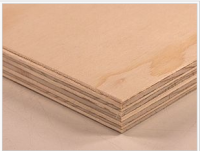








Plywood is a sheet material manufactured from thin layers or ""plies"" of wood veneer that are glued together with adjacent layers having their wood grain rotated up to 90 degrees to one another. It is an engineered wood from the family of manufactured boards which includes medium-density fibreboard (MDF) and particle board (chipboard).
In 1797 Samuel Bentham applied for patents covering several machines to produce veneers. In his patent applications, he described the concept of laminating several layers of veneer with glue to form a thicker piece – the first description of what we now call plywood. Samuel Bentham was a British naval engineer with many shipbuilding inventions to his credit. Veneers at the time of Bentham were flat sawn, rift sawn or quarter sawn; i.e. cut along or across the log manually in different angles to the grain and thus limited in width and length.
About fifty years later Immanuel Nobel, father of Alfred Nobel, realized that several thinner layers of wood bonded together would be stronger than one single thick layer of wood,understanding the industrial potential of laminated wood he invented the rotary lathe.
There is little record of the early implementation of the rotary lathe and the subsequent commercialization of plywood as we know it today, but in its 1870 edition, the French dictionary Robert describes the process of rotary lathe veneer manufacturing in its entry Déroulage.One can thus presume that rotary lathe plywood manufacture was an established process in France in the 1860s. Plywood was introduced into the United States in 1865 and industrial production started shortly after. In 1928, the first standard-sized 4 ft by 8 ft (1.2 m by 2.4 m) plywood sheets were introduced in the United States for use as a general building material.
As for artists’ use of plywood as support for easel paintings, replacing traditional canvas or cardboard; ready-made artist boards for oil painting in three-layered plywood (3-ply) were produced and sold in New York as early as 1880.